#faiance
Text
too disorganised today to have any structure of thought but. faiance is absolutely way too cool to ignore, and I've suddenly gotten very into ancient egyptian jewellery (esp. the amarna necklace @ petrie) and boy. they also used turquoise and carnelian and amethyst and I. am a geologist. these things make me go brrrr. anyways, i've just bought loads of beads. gonna make things. don't know what yet but things. will be made.
#not actually faiance but. faiance is SO COOL#the shabti display#loved it to bits. iconic#ancient egypt and archeology
6 notes
·
View notes
Photo

@antiqueartlove AntiqueArtLove #transferware #transferwarechinapottery #etsy #etsyshop #etsyseller #collection #faiance #frenchfaiance #old #blueandwhite #plate #antiquepitcher #garden #mygarden #oldwood #washingtondc #oldkitchen #fleamarketfind #happyday #mutimitnezel #szeretemamunkam # (at New York, New York) https://www.instagram.com/p/BzTbddRH2IH/?igshid=1apxv5biens2a
#transferware#transferwarechinapottery#etsy#etsyshop#etsyseller#collection#faiance#frenchfaiance#old#blueandwhite#plate#antiquepitcher#garden#mygarden#oldwood#washingtondc#oldkitchen#fleamarketfind#happyday#mutimitnezel#szeretemamunkam
0 notes
Video
<strong>Reality shows before TV 01 <a href="https://www.flickr.com/photos/boscdanjou/">by Bosc d'Anjou</a></strong>
Menino Gordo [Fat child, Matteo Perrero]. Faience plate attributed to Fábrica da Fervença, Vila Nova de Gaia, ca. 1842-43. Deposited with the Museu Nacional Soares dos Reis, Porto.
The story of these plates: Once upon a time, there were two children from Piemonte, Matteo Perrero (b. 1931) and his sister Anna (b. 1833) who were shockingly obese. Matteo, at age 11, weighed 201 kg. His waist circumference (1,68 m) exceeded his height (1,52 m). Ana, at age 9, weighed 129 kg for a height of 1,37 cm and a waist of 1,47 cm. This was the stuff of reality TV before TV, so they were exhibited around Europe, including at the royal courts of Piemonte, France, Spain and Portugal. They were also exhibited to the general public. In Portugal, where they travelled for several months in 1842-43, it is documented that they were shown to Queen Maria II and then displayed usually for 11 hours day in Porto, Braga and Guimarães. They travelled in an oxcart (covered with some sort of tarpaulin, so as not to provide free sightings) and were accompanied by their mother and a military escort.
Their appearances in the north of Portugal were a huge success and many people wanted souvenirs of what they had seen. The earthenware industry around Porto was eager to respond to the demand for merchandising and throughout the 1840s the "meninos gordos" (fat children) - particulary Matteo - were the subject of plates, mugs, toothpick holders and other earthenware pieces.
See Isabel Silva Fernandes, Meninos Gordos Faiança Portuguesa. Civilização Editora, 2005.
#Portugal#Porto#faiance#earthenware#plate#ceramic#menino gordo#Matteo Perrero#obesity#reality show#freak show#Museu Nacional Soares dos Reis#Fábrica da Fervença#Isabel Silva Fernandes#fat child#fat boy
2 notes
·
View notes
Photo

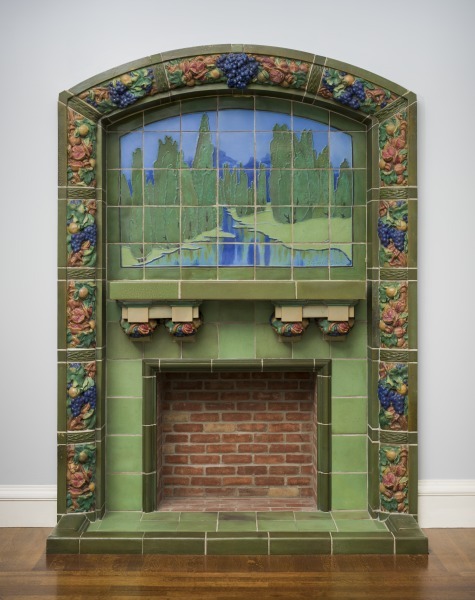
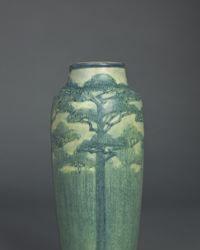

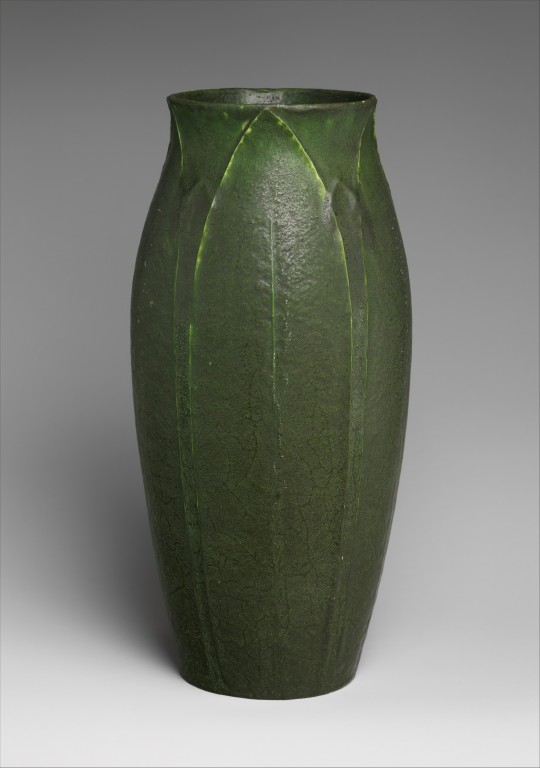
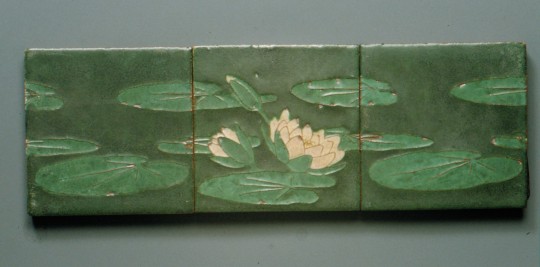
American Arts and Crafts Pottery
The artists and designers of the Arts and Crafts Movement worked in many different mediums in their attempts to create beautiful, affordable objects that would improve the lives of both those who made them and those who lived with them. Of these many mediums, pottery perhaps best encompassed the Arts and Crafts ethos.
As a common material used for everyday objects, pottery lent itself to the idea that objects should be both functional and beautiful, and because clay was a common and readily available material, pottery could be produced relatively inexpensively. This allowed art pottery to be sold at a price point that made it available to much of the population. Additionally, pottery manufacture, from the creation of the vessel, to its glazing and decoration, and on to its firing and finishing, was a process that a single potter or small group could easily and economically complete by themselves. Thus ceramic manufacture lent itself to the Arts and Crafts ideal of the engaged workman, rather than the alienated, distributed process industrial laborer. Finally, it was relatively inexpensive to set up a pottery studio and kiln, but the versatility of clay and the chemical complexity of firing and glazes meant that potters could easily start up their own art pottery manufacture, and then spend a life time perfecting it.
Some of the best know American Arts and Crafts pottery makers were the Rookwood Pottery Company, Newcomb College Pottery, Teco, and the Grueby Faiance Company
Decorating pottery was considered appropriate work for women in the late nineteenth century. Two major pottery manufacturers were notable for hiring women decorators: Rockwood Pottery Company and the Newcomb College Pottery.
Rockwood Pottery Company was founded in 1880 in Cincinnati, Ohio by Maria Longworth Nichols Storer, the daughter of a wealthy Cincinnatian. Storer was inspired by the Japanese and French ceramics she saw at the Centennial Exhibition in Philadelphia. Rockwood pottery tended to focus on glaze and under glaze decoration on beautifully, but other wise conventionally formed vessels.
Early Rookwood pottery tended to feature floral under glaze decoration or generic portraits of American Indians under warm colored, high gloss glazes. As Arts and Crafts style pottery became more popular, Rookwood produced a matte glaze that was used over their usual floral decoration. In the early 1900s, Rookwood began producing architectural ceramics was well, and their tile and fireplace surrounds were used in a number of great houses and public places in the region.
Newcomb College Pottery was made as part of the ceramics program at the Sophie Newcomb Memorial College, a women’s college that is now associated with Tulane University in New Orleans. Newcomb College was founded to instruct southern women in the liberal arts, and the art school opened in 1886. It began to produce art pottery on a for-profit basis in 1895 under the supervision of art professors William Woodward, Elisworth Woodward, and Mary Given Sheerer. Like Rookwood, Newcomb pottery focused on surface decoration, rather than the over all shape of the vessels- decorating pottery was considered appropriate work for women, but throwing and firing ceramics was not. Most Newcomb pottery was decorated with plant, animal, and landscape motifs drawn from its southern surroundings.
While both Rookwood and Newcomb pottery focus on surface decoration for their impact, Teco Pottery was notable for its shape and form. Teco was the art pottery line produced by the American Terracotta and Tile Company. The company was founded in Terra Cotta, Illinois, near Chicago, in 1889. American Terracotta original y only produced architectural ceramics such as drain tile, brick, and chimney pots, however, its founder, William Day Gates soon began to experiment with forms and glazes with the intent to create an art pottery line. Gates would develop a smooth, matte green glaze, known as Teco Green for his art pottery. Teco Pottery would attract the attention of several Prairie Style architects and designers with its clean, geometric forms, most notably, Frank Lloyd Wright. Teco Pottery came to be strongly associated with the Prairie style, and was popular for decorating the ubiquitous Chicago Bungalow style house.
The Grueby Faience company was founded in 1894 in Revere, Massachusetts by William Henry Grueby. Like Roockwood’s Maria Longworth, Grueby was also inspired by the matte glazes of French pottery and the simplicity of Japanese ceramics, which he saw at the World’s Colombian Exposition in Chicago in 1893. Like Teco, Grueby pottery tended to focus on simple, elegant forms covered in Grueby’s hallmark matte green glaze. Grueby Faience was a well known, and its pottery was sold in Samuel Bing’s famous gallery in Paris, L’Art Nouveau, as well as by Tiffany &Co. Although they are better know for their art pottery, Grueby Faience Company also made architectural tile, some of which can still be seen in New York Subway stations.
Image 1: The Rookwood Pottery Company is best known for their floral underglaze decoration, and was notable for hiring women pottery painters.Vase, The Rookwood Pottery Company, 1890, earthenware.
Image 2 Rookwood also began producing architectural cerramics such as tile and fireplace surrounds in the early 1900s.Chimneypiece, John Hamilton Delaney Wareham for The Rookwood Pottery Company, 1905-1920, architectural faience.Image credit Cincinnati Art Museum.
Image 3: The Sophie Newcomb Memeorial College opened in 1886 to instruct Southern women in the liberal arts. Newcomb College Pottery began producing pottery on a for profit basis in 1895. Vase with Cypress Pine Wood Design, Anna “Fanny” Frances Connor Simpson for Newcomb College Pottery, 1912, earthernware.Image credit Newcomb Art Museum.
Image 4: Teco was the art pottery line produced by American Terracotta and Tile. Their simple, geometric forms made them popular with the architects of the Chicago Prairie School, and a number of those architects, including Frank Lloyd Wright, produced designs for Teco. Sumac Vase, Frank Lloyd Wright (designer), Teco Pottery (maker) ca. 1903, ceramic, Dana-Thomas House.
Image 5:William Henry Grueby began producing ceramics inspired by the matte glazes of French ceramics and the simplicity of Japanese pottery in 1894. Grueby Faience Company is best know for its made green glazes. Vase, Grueby Faience Company, ca. 1900-1910, earthenware.Image credit The Metropolitan Museum.
Image 6:Like Rookwood, The Grueby Faience Company also began to produce architectural tile. Some of it can still be seen in New York subway stations. Tile, The Grueby Faience Company, 1894-1911, earthenware.Image credit The Metropolitan Museum.
#Art history#arts and crafts movement#ceramics#pottery#art pottery#american art pottery#prairie style
19 notes
·
View notes
Photo
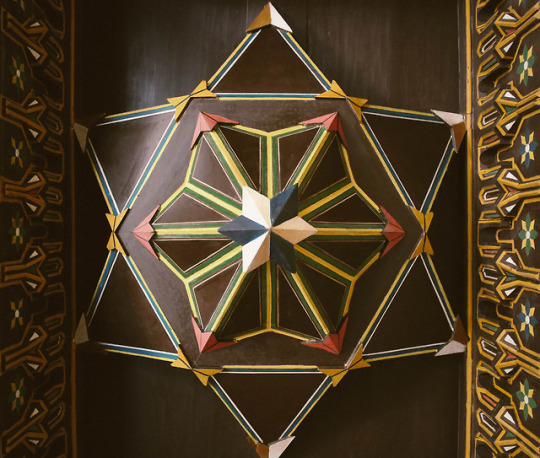
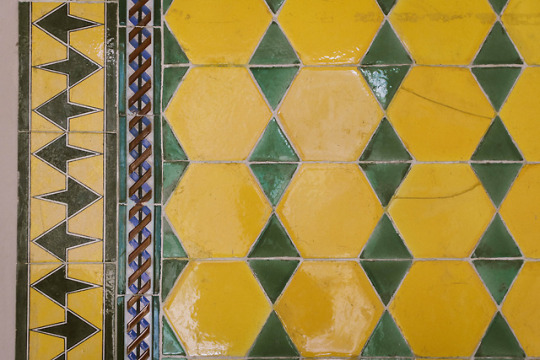
I don’t think I will ever get bored of the geometries of the Islamic architecture. It’s amazing how only one shape can generate so many designs and patterns. This time we focus on a couple of details with hexagons from the Manial Palace.
#hexagon#islamic#islamicdecor#pattern#yellow#architecture#architecturelovers#faiance#symmetry#decor#interior#interior design#interior decorating#decoration#cairo#alqahira#cairoegypt#manial
0 notes
Photo

Presepe spirale #sansperatepaesemuseo #giampaolomameli #sardegna #scultura #art #artist #artigianatosardo #artsy #beautiful maiolica #faiance #handcrafted #madeinitaly #handmade #sculpture #contemporaryart #handcrafted #ceramics #ceramicsart #sardinia #decor #sardegna #pottery #artwork #design #designer #interiordesign #artigianato #raku #fattoamano (presso Giampaolo Mameli - bottega d'arte ceramica)
#ceramics#ceramicsart#art#contemporaryart#scultura#madeinitaly#artist#sardegna#artigianatosardo#sardinia#sculpture#pottery#artsy#design#artwork#beautiful#faiance#designer#handmade#sansperatepaesemuseo#interiordesign#raku#fattoamano#giampaolomameli#handcrafted#decor#artigianato
0 notes
Text
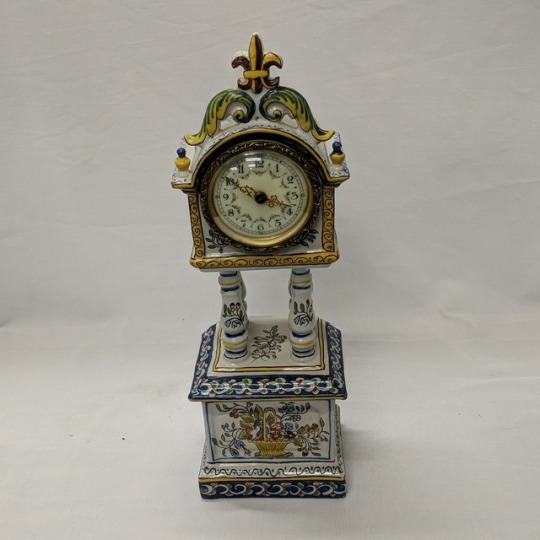
#flashbackfriday to this 19th Century ceramic French Faiance Clock. It is a two tier clock supported by decorated pillars in the center. The entire piece is decorated in a blue, yellow, and green floral pattern, with an enamel dial decorated with floral designs around it's Arabic numerals. The movement inside resembles that of a watch.
9 notes
·
View notes
Link
I just added this listing on Poshmark: Fine Faiance serving plate.
0 notes
Photo

😍🇪🇬🌷photo exclusively for our page😍🇪🇬 Don't take my photos without logo😊 Jewellery from ancient Egypt Necklace. Made of blue, green and orange faience A scarab ring, made of gold and blue faiance. New Kingdom Mummies - a journey to the hereafter. Tampere, Finland #Tutankhamun. #BritishMuseum #egyptianmuseum #MuseumFromHome #bkmegyptianart #ancientring #Egypt #AncientEgyptian #JewelryAncientEgyptian #Jewelleryancientegyptian #ringsancientegyptian #scarabsrings #scarabs #newkingdom #jewellerybloger #instajewelry #egyptological #egyptianjewelry #tutankhamón #18Dynasty #newkingdom #metmuseum (at Tampere, Finland) https://www.instagram.com/p/CECcqR1BHSQ/?igshid=mg3eg0ialy5l
#tutankhamun#britishmuseum#egyptianmuseum#museumfromhome#bkmegyptianart#ancientring#egypt#ancientegyptian#jewelryancientegyptian#jewelleryancientegyptian#ringsancientegyptian#scarabsrings#scarabs#newkingdom#jewellerybloger#instajewelry#egyptological#egyptianjewelry#tutankhamón#18dynasty#metmuseum
0 notes
Video
Odeon Bristol Screen by Richard Walker
Via Flickr:
The Odeon Bristol Showing the Screen masked for 70mm Todd-AO, presentation. This Odeon was one of the original Oscar Deutsch chain of Odeon Theatres Ltd. The Bristol Odeon opened on 16th July 1938 with Deanna Durbin in "Mad About Music". The cinema had a large rotunda corner entrance located on Union Street and Broadmead. The facade is covered with cream faiance tiles. Inside the auditorium, the original seating capacity was provided for 1,945; 1,051 in the stalls and 894 in the circle. The decorative scheme was stepped bands of plaster in the ceiling which contained concealed lighting troughs.
0 notes
Photo
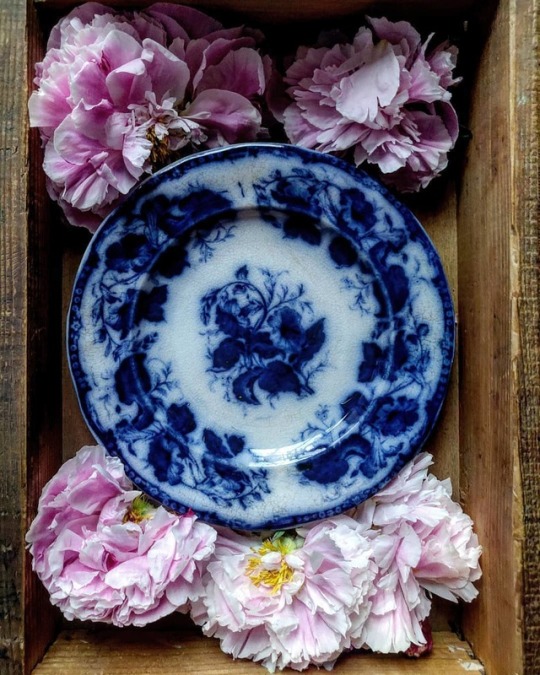
@monika.marky #antique#vintage #faiance #oldfaiance #flowblue #blueandwhite #plate #beautifuloldthings #mytreasure #myphoto #antique_r_us #still_life_gallery #loves_vintage #tea_cup_tuesday #tv_retro #still_life_mood #brocante #stilllife_perfection #stilllife #fleamarkets #fleamarketfinds #transferwarechinapottery (at New York, New York) https://www.instagram.com/p/By8P69xnfQZ/?igshid=164185if2tb4
#antique#vintage#faiance#oldfaiance#flowblue#blueandwhite#plate#beautifuloldthings#mytreasure#myphoto#antique_r_us#still_life_gallery#loves_vintage#tea_cup_tuesday#tv_retro#still_life_mood#brocante#stilllife_perfection#stilllife#fleamarkets#fleamarketfinds#transferwarechinapottery
0 notes
Video
<strong>Reality shows before TV 02 <a href="https://www.flickr.com/photos/boscdanjou/">by Bosc d'Anjou</a></strong>
Menino Gordo [Fat child, Matteo Perrero]. Faience plate attributed to Fábrica da Afurada, Vila Nova de Gaia, ca. 1842-43. Deposited with the Museu Nacional Soares dos Reis, Porto.
The story of these plates: Once upon a time, there were two children from Piemonte, Matteo Perrero (b. 1931) and his sister Anna (b. 1833) who were shockingly obese. Matteo, at age 11, weighed 201 kg. His waist circumference (1,68 m) exceeded his height (1,52 m). Ana, at age 9, weighed 129 kg for a height of 1,37 cm and a waist of 1,47 cm. This was the stuff of reality TV before TV, so they were exhibited around Europe, including at the royal courts of Piemonte, France, Spain and Portugal. They were also exhibited to the general public. In Portugal, where they travelled for several months in 1842-43, it is documented that they were shown to Queen Maria II and then displayed usually for 11 hours day in Porto, Braga and Guimarães. They travelled in an oxcart (covered with some sort of tarpaulin, so as not to provide free sightings) and were accompanied by their mother and a military escort.
Their appearances in the north of Portugal were a huge success and many people wanted souvenirs of what they had seen. The earthenware industry around Porto was eager to respond to the demand for merchandising and throughout the 1840s the "meninos gordos" (fat children) - particulary Matteo - were the subject of plates, mugs, toothpick holders and other earthenware pieces.
See Isabel Silva Fernandes, Meninos Gordos Faiança Portuguesa. Civilização Editora, 2005.
#Portugal#Porto#faiance#earthenware#plate#ceramic#menino gordo#Matteo Perrero#obesity#reality show#freak show#Museu Nacional Soares dos Reis#Fábrica da Afurada#Isabel Silva Fernandes#fat child#fat boy
1 note
·
View note
Text
Fresh Carrelage Mural Adhesif Salle De Bain Brico Depot
Fresh Carrelage Mural Adhesif Salle De Bain Brico Depot
[gembloong_breadcrumbs]
[gembloong_ads1]
carrelage mural cuisine brico depot luxe 27 meilleur de de carrelage salle de bain belgique parfait brico depot abri de jardin luxe balatome brico depot elegant collection de brico depot carrelage cuisine carrelage faience cuisine brico depot élégant autocollant cuisine charmant carrelage mural cuisine brico depot plan de travail salle de bain carrelage…
View On WordPress
0 notes
Text
Fresh Carrelage Mural Adhesif Salle De Bain Brico Depot
Fresh Carrelage Mural Adhesif Salle De Bain Brico Depot
[gembloong_breadcrumbs]
[gembloong_ads1]
carrelage mural cuisine brico depot luxe 27 meilleur de de carrelage salle de bain belgique parfait brico depot abri de jardin luxe balatome brico depot elegant collection de brico depot carrelage cuisine carrelage faience cuisine brico depot élégant autocollant cuisine charmant carrelage mural cuisine brico depot plan de travail salle de bain carrelage…
View On WordPress
0 notes
Photo
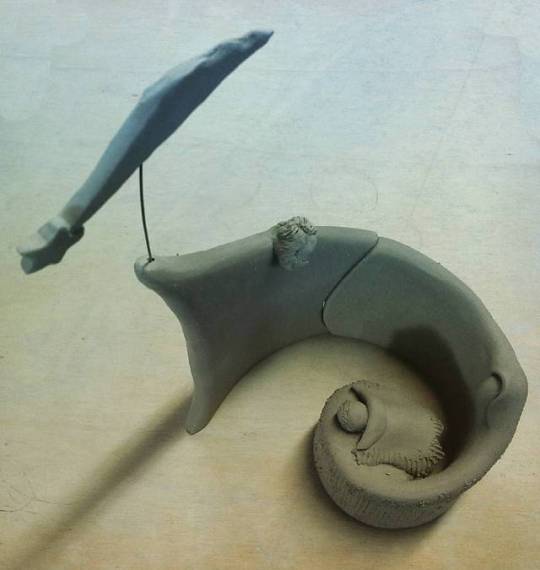
I miei presepi a spirale - work in progress #sansperatepaesemuseo #giampaolomameli #sardegna #scultura #art #artist #artigianatosardo #artsy #beautiful maiolica #faiance #handcrafted #madeinitaly #handmade #sculpture #contemporaryart #handcrafted #ceramics #ceramicsart #sardinia #decor #sardegna #pottery #artwork #design #designer #interiordesign #artigianato #raku #fattoamano (presso Giampaolo Mameli - bottega d'arte ceramica)
#design#sardinia#sculpture#artsy#sansperatepaesemuseo#artigianatosardo#decor#ceramicsart#handcrafted#contemporaryart#ceramics#faiance#handmade#artigianato#madeinitaly#beautiful#art#artwork#pottery#giampaolomameli#raku#designer#fattoamano#sardegna#scultura#interiordesign#artist
0 notes



